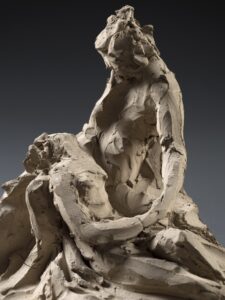
It will be my great pleasure to share some tricks I’ve learned over the years to sketch and sculpt the human form in clay, wax or plastilina. Quick sketches, careful measurements and plastic sculpting mediums help us get the most out of our time with a live model… and provide inspiration for later pieces. One of the most important skills you will take away from this class are the simple steps that will turn your maquette into a piece that is technically right for successfully firing or casting into bronze. When you know these techniques, your studies can become salable pieces exhibited alongside your finished stone. We will spend the first three hours sketching the model. Both Sabah and I will be sharing our knowledge with you. I like to work with charcoal and will be showing you some quick shading tricks for capturing values that describe volume. See the attached supply list for what to bring for this part of the class.
The next two mornings will be spent building a torso in clay or wax. The torso is the most vital area of the body and will provide the most planes and curves … it’s also the fastest area to build. We have a lovely model I’ve worked with before, and you should be able to take home a completed piece. I will discuss methods for building in plastilina (an oil-based clay), wax working, and terra cotta. Plastilina is used to build a model from which a mold is made. The material used to pour into the mold can be plaster, cold cast stone or bronze, cement or hot cast bronze. Wax models are usually made for lost wax bronze casting, or if small enough-silver or gold. I have worked with these materials for about 25 years, and along the way, learned some great tricks in the commercial jewelry production industry. Technically, wet clay is the easiest to work with, and the quickest way to a finished piece. It’s what I will use to build my demonstration piece. Following are the tools you might want ot bring for this class, and quick instructions for a simple, reuseable armature. I’m looking forward to our time at Camp Brotherhood.
Many of these tools are simple things you will have around the house or studio. I will have extra of many of the following. There will be clay, some wax and some plastilina to purchase at the symposium. If you have them, bring them. If you plan to work in wax, bring your own tools and a simple alcohol burner and denatured alcohol. (I will not have extra of these.)
Drawing
Wax Modeling
Terra Cotta & Plastilina:
Amature
To build your armature, you will need a 10 x 10″ piece of plywood, a galvanized flange, galvanized screws and a 10″-12″ piece of threaded galvanized pipe. (plastic pipe can be substituted-use the smallest diameter pipe and flange you can find.) Seattle plywood if you like, but it is not necessary, and mount flange and pipe in its absolute center. This armature will work for most torsos and busts build from clay, wax, or plastilina.



We need some kind of descriptive text here.